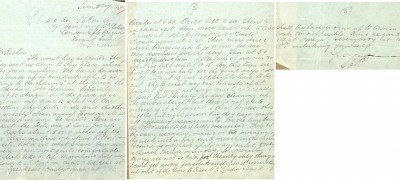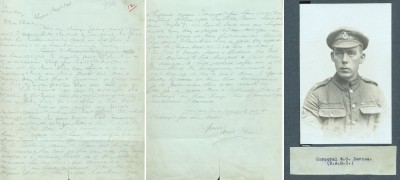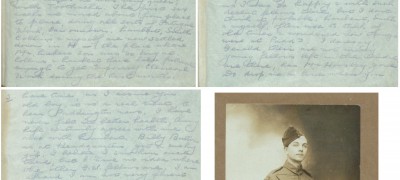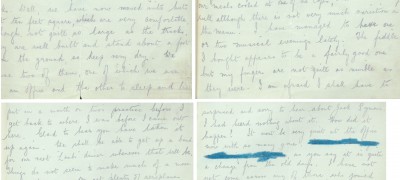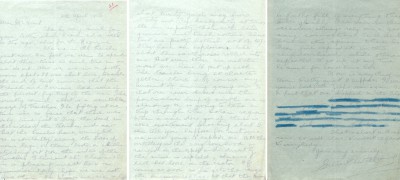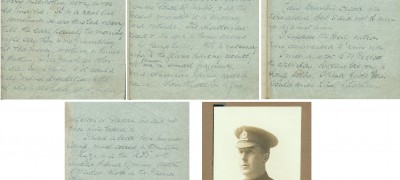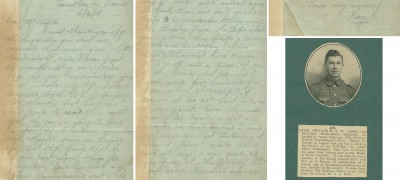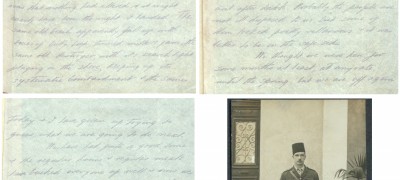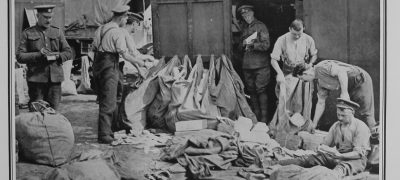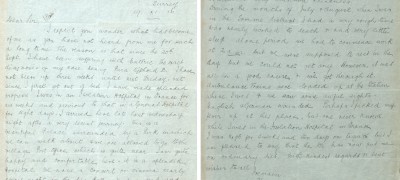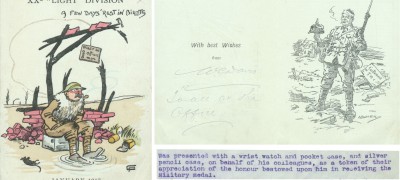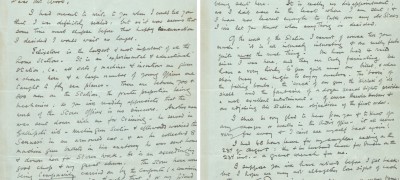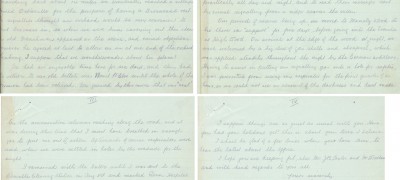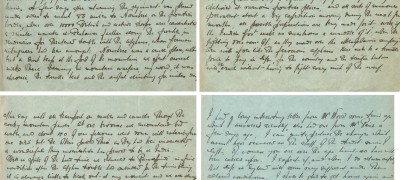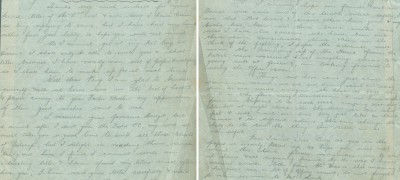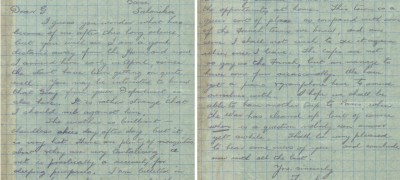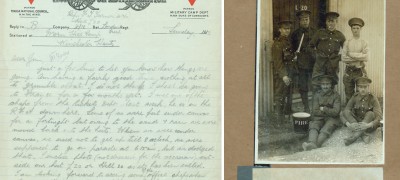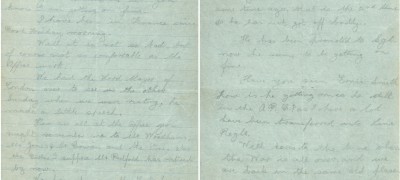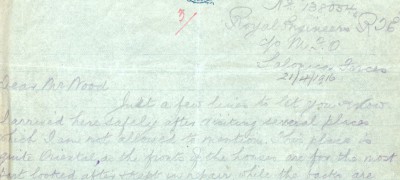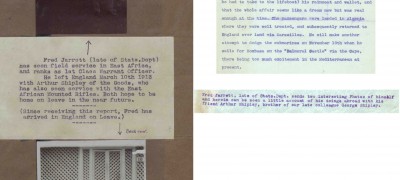
Download documents and transcripts
Teachers' notes
There are 35 letters and 19 photographs in this resource. All letters have been transcribed, and audio versions of selected letters are available too. The documents should offer students a chance to develop their powers of evaluation and analysis. Teachers may also wish to use the collection to develop their own resources.
You may spot spelling or grammatical errors in the transcripts as we have transcribed the letters as they stand. Unusual or technical terms have been defined within the text. However, we have not included full digital images for several letters as these would have proved too difficult to read online. In such cases we have shown part of the letter in order to provide a sense of the original. There are five accompanying PDFs, each containing a collection of letters on the themes of hospital, different fronts, trenches, railheads and training.
Within this online resource and the accompanying collection Letters from the First World War, part one (1915), it is possible to find more than one letter from the same person, or find references within the letters to those who have written. For this reason is it is helpful to see the letters as a whole group to get the most out of them and appreciate the nature of the collection.
Letters from the First World War, part two (1916-1918) is based on the second half of the RAIL record. We have labelled each letter according to a theme from the First World War. For example, some letter writers continue to detail their experience of the trenches, or service in Egypt, Greece, India and Aden.
As more soldiers were conscripted they have also described their training before going abroad. Others write about being in hospital or conditions at the railheads in France. Railheads were the nearest points to the front from which men and supplies travelled by train and were then taken to the battle line by motor vehicle or horse.
The Great Western Railway Company formed four companies of Royal Engineers as many men from the company, including these clerical workers from Paddington, had enlisted to serve. Due to their knowledge and understanding of the railways, many became Railway Troops based at railheads.
Unsurprisingly, in the letters many men showed a keen interest in all matters connected with railways or engines, including other Great Western Railway ‘fellows’ and the Great Western Railway Magazine. Some soldiers mentioned having received the magazine or asked for it to be sent out. It included photographs of all those who served in the First World War from the GWR as a whole and employees could catch up on company business and or news of sporting or social events.
How to use this resource
- Discuss any of the suggested questions below on a group/individual basis.
- Assign groups of letters on a given theme to groups/individuals in order to explore and interpret.
- Students could curate their own exhibition on the letters based on a theme/question of their choice using additional original material/secondary sources.
- Carry out research on the life of an individual soldier. Our research guide can help get you started.
- Use this resource in conjunction with our first online resource, which includes letters from the earlier war period: Letters from the First World War, part one (1915), to consider further themes and ideas.
- Student work could be presented via a mix of media: Powerpoint presentation, video film, radio documentary, newspaper article, role play interview, poster, blog, web page or classroom exhibition.
Suggested questions:
- How does their experience of the First World War vary among these letter writers?
- What training was carried out before they were sent to fight?
- How did the men feel about their experience of training?
- What can be found out about tactics/weapons/equipment used in combat?
- Do you get a sense of what these soldiers miss from home? Is this unsurprising/shocking?
- Describe conditions for those in the trenches on Western Front.
- What were conditions like for those who were sent to the Dardanelles?
- Can you get a sense of the experience of those who fought in Greece, India or Egypt, East Africa?
- How was the treatment of the sick or injured organized at home and abroad?
- Is there evidence of what the men thought of those whom they fought/or of their comrades?
- Do any soldiers give their opinion about the war?
- Do you think these men are typical of those who went to war?
- Can we find out anything about the characters of the men who fought from these letters?
- Have you found anybody who has written more than once, or spot any links between the letters which highlight particular friendships?
- Considering who the soldiers are writing to, can you explain if this has influenced the tone or style of the letters? Give examples.
- Is it clear if any details have been left out/put in for particular reasons?
- Can you discover a difference between what is being said and how it is being said in any of the letters?
- Which letters have you found the most interesting/funny/moving to read?
Working with written documents
For help on how to work with the letters you could take a look at the student section of our website where you can also find a brief guide on working with records.
You could also use the Start here section of our website The Victorians as an introduction on how to work with the sources, although all the examples in the site relate to the Victorian era.
Working with images
When studying the photographs and postcards in the collection, it is helpful to explore the idea that they were produced to provide a particular message. Pupils ought to consider the purpose and audience for which these sources were intended.
Thus for photographs it is useful to look at key aspects of their composition such as lighting, pose, background, foreground, formality, lack of formality and so on and evaluate the original caption if given. A further group of images from this record can be viewed on our Flickr board First World War letters.
Connections to the curriculum
- Key stage 3: Challenges for Britain, Europe and the wider world 1901 to the present day
- Key stage 4: History B Modern World OCR: Depth Study The causes & Events of the First World War
- Key stage 4: History (A) Edexcel: The Making of the Modern World: Unit 1 Peace and War International Relations 1900-1991. Teachers could use these letters to support contextual study
- Key stage 4: History B Modern World OCR: Depth Study The causes & Events of the First World War
- Key stage 5: A/AS Level English Literature courses with options to study the ‘War Poets’. Teachers could use these letters to support contextual study
Introduction
‘Our family has had to pay the penalty of war that so many thousands of families have done, for I am now the only one out here’
These few words, written by Frederick Ernest Andrews on 16 October 1917 from France, come from this collection of letters from staff at the Audit office for the Great Western Railway (GWR) based at Paddington, London.
What makes this collection of soldiers’ letters so different from all others is the fact that it reveals the stories of a particular group of men who varied in class and education, who were writing back to their colleagues and bosses in the office while on active service during in the First World War. Many men enlisted from the GWR to fight, but these letters come exclusively from those worked at its Audit office. Staff at Paddington covered a range of different roles in insurance, accounting or ticketing for the Great Western Railway.
The letters (RAIL 253/516) belong to the RAIL series (which includes the records of the railway companies) at The National Archives. They are arranged in 12 carefully bound folders, rather like a series of scrapbooks. Starting from August 1915, each part represented what was known as the office newsletter, a collection of letters, photographs postcards, field cards and contemporary newspaper cuttings from those who had gone to fight. Every newsletter opened with a news section listing those who had written and sent photos to the office and those who recently left to company to serve at the front. The totals of all men in khaki from the Audit office were given too. The news section also provided information about those who had died, been injured, visited the office on leave or been promoted. The newsletters were circulated within the office departments and read by men when they came home on leave. Friends or relatives who had been sent their own letters or photographs often lent them or typed them out to be circulated as part of the regular Audit office newsletter.
The Audit office raised enough money through collections and the sale of Christmas cards, to create a temporary roll of honour for the office at Paddington to commemorate those who had fallen in battle by August 1915. Photographs of the Roll of Honour were sent out to several employees as their correspondence reveals.
After the war had ended and troops had returned, the G.W.R. was able to quantify the contribution that it had made to the cause. The contribution made by the Audit office was high: 55.5% of male staff enlisted, whereas the average rate of enlistment across the GWR was 32.6%. This amounted to 184 men, 17 of whom lost their lives.
On 11 November 1922, The Great Western Railway War Memorial, dedicated to all 2,524 staff who had died in battle was unveiled on platform 1, Paddington station.
External links
The First World War Digital Poetry Archive includes primary material from major poets Wilfred Owen, Isaac Rosenberg, Robert Graves, Vera Brittain, and Edward Thomas.
The National Archives’ Pinterest board Teaching the First World War, highlights The National Archives and other resources from the web.
The ‘A Street Near You‘ project maps individual soldiers’ records to their homes, globally, allowing us to see who served in the war on a local level.
Related resources
When The Office Went To War, a collection of over 200 letters from men of the GWR who went to war.
These are all aimed primarily at KS3 and KS4 students.
Letters from the First World War, part one (1915). Part one of this online resource, which covers the later period of the war.
The National Archives has recorded some podcasts using extracts of letters from Private ‘Frosty’, Freddy Woodhams and Harold Watts.
Zeppelin raids Our lesson which asks students: How did First World War Zeppelin raids affect British civilians?
Focus on film , a series of film clips on the First World War is available in our Focus on Film resource.
Back to top
